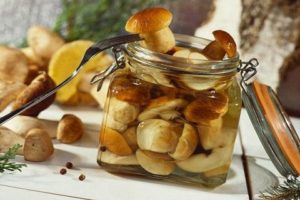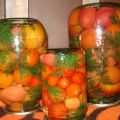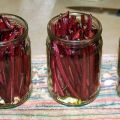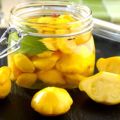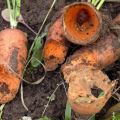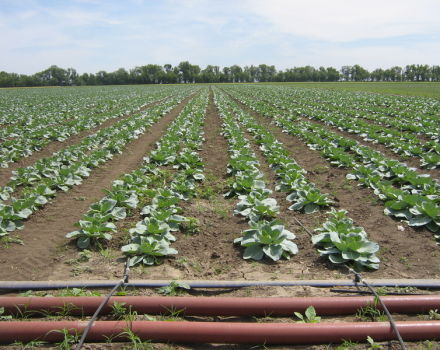Simple recipes for making pickled cucumbers with carrot tops for the winter
More often, cucumbers are harvested for the winter according to standard recipes - with the addition of dill, bay leaves and spices, but the preparation prepared with carrot tops acquires a completely new taste and aroma. Cucumbers are savory, rich and aromatic. Moreover, such preservation is distinguished by its usefulness and ease of preparation.
general information
It is better to salt vegetables in late August and early September. At this time, late varieties of cucumbers ripen, and carrot tops are rich in essential oils, which will add new flavors to the conservation. You should also know that the vegetable preparation is saturated with aromas and tastes at least three months after canning, so you should not open the treat in advance.
The benefits of carrot tops
Including carrot tops in the diet, you need to take into account its usefulness, which has been thoroughly studied, both in medicine and in cooking. The beneficial properties of greens are due to their chemical composition.
It is the green part of the plant that contains 500 times more minerals, vitamins and trace elements than the orange root crop itself, such as:
- selenium is a powerful natural antioxidant;
A small bunch of carrot tops, consumed on an empty stomach, covers the daily requirement for selenium.
- carotene - in the body is processed into vitamin A, which gives youth to the skin;
- vitamins: C, PP, E, D, group B, necessary for the functioning of the body;
- minerals and trace elements: phosphorus, fluorine, iodine, magnesium, potassium, iron, zinc, manganese.

Thanks to this, carrot tops help to increase immunity, neutralize food toxins, cleanse the blood, get rid of edema and improve muscle and skin tone. The tops are 1.3% protein and 7% carbohydrates.
It is saturated with herbs and essential oils, which, for all their usefulness, also give a sweetish taste to the workpieces.
The low calorie content of greens should also be noted - only 35 kilocalories per 100 grams.
Selection and preparation of the necessary products
Before you start preserving vegetables, you need to take into account several recommendations that will make the treats appetizing and rich:
- Choose only fresh herbs for clogging. If carrots grow in the garden, then cut off the tops from it immediately before cooking.
- Look after fresh, green cucumbers, up to 10-13 centimeters in size. Spoiled, overripe specimens with large seeds are not suitable for harvesting.
- The color of a vegetable directly depends on its age. The younger the cucumbers, the greener the color of the fruit, and vice versa.
- Cucumbers of universal and pickling varieties are suitable for recipes. The vegetables have a thin skin that helps the pickle absorb quickly.Such fruits, in contrast to salad fruits, have dark tires.

Before preparing, all the ingredients must be properly prepared:
- Rinse each fruit well under running water, soapy water or baking soda.
- Trim the tails of the vegetable.
- Pour cucumbers with water at room temperature for 2 to 8 hours. Thus, you can also get rid of the vegetable from nitrates by 15%.
- Pour cold water over the vegetables again and lay them out on kitchen towels.
When canning vegetables, pour the marinade into containers up to the very neck so that the water overflows a little.
- Rinse the tops of the tops with water and shake off excess moisture.
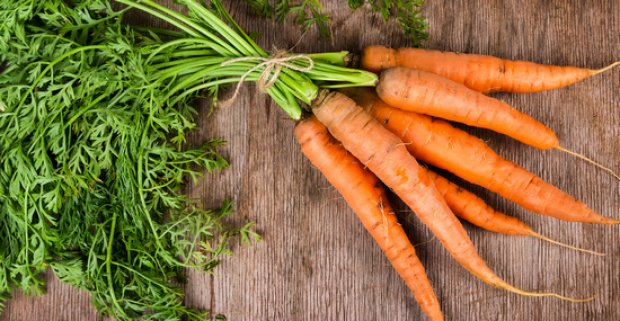
You also need to prepare the jars in advance by sterilizing them in an ordinary, convenient way. It is better to wash the lids with baking soda and boil for 10 minutes.
Pickled cucumbers with carrot tops for the winter, without pasteurization
Ingredients for 4 liter containers:
- Water - 2 liters.
- Salt - 2 tablespoons.
- Sugar - 7 tablespoons.
- Vinegar - 200 milliliters.
- Tops - 4 branches.
- Cucumbers - 2 kilograms.
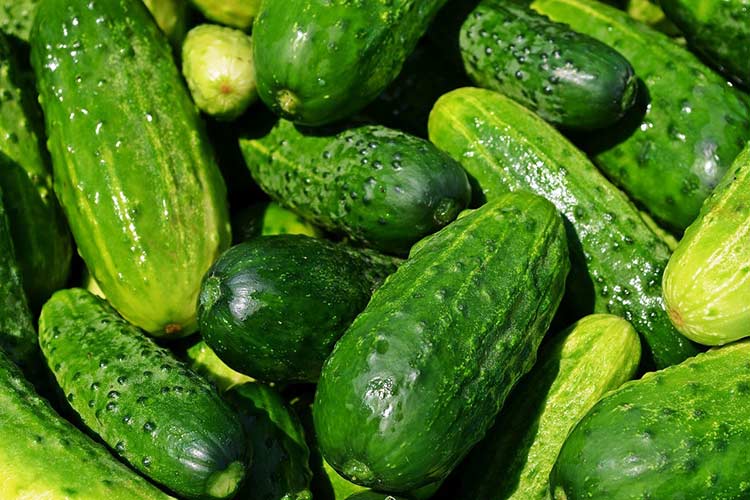
Salting an unusual delicacy is as follows:
- Spread the prepared leaf branches on the bottom of the sterilized containers.
For a beautiful spring look, the tops can be packaged both at the bottom of the glass container and added along the walls.
- Place the soaked and pre-washed cucumbers tightly on top of the greens.
- Pour boiling water over jars of vegetables. Cool the liquid to room temperature.
- Drain the water back into the pot by adding the salt and sugar. Boil the solution again.
- Pour vinegar into the bubbling liquid, and once again bring the mass to a boil.
- Close the jars with disinfected lids. Turn containers upside down. For the seaming to undergo additional pasteurization, wrap it with a warm blanket.
- After cooling completely, move the jars to a cool storage area.

With tomatoes
The method of such preparation will surprise even experienced chefs and amaze with its unsurpassed taste, because you can pickle cucumbers with carrot tops right away with tomatoes.
Ingredients for a three-liter container:
- Carrot tops - 1 bunch.
- Hot pepper - 1 piece.
- Salt - 2 tablespoons.
- Sugar - 4 tablespoons.
- Vinegar - 5 tablespoons.
- Cucumbers, tomatoes - in equal parts.
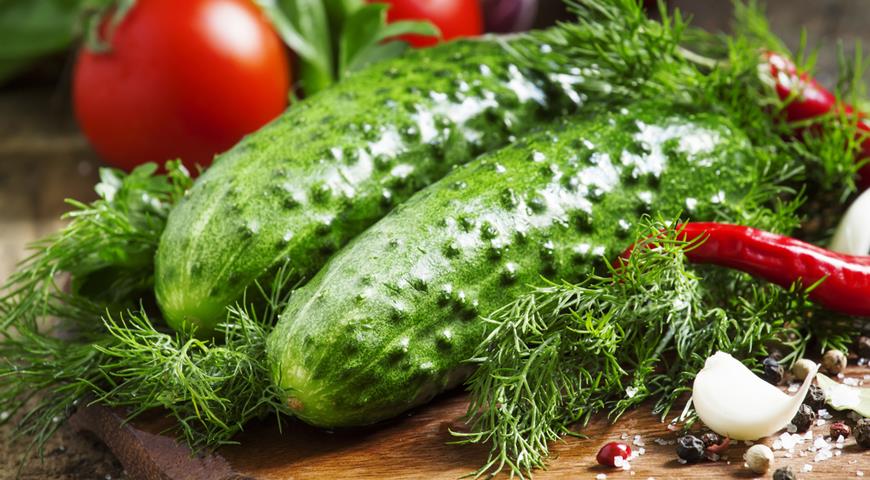
You need to salt vegetables as follows:
- First you need to rinse the vegetables, tops of the tops and dry them well. Soak cucumbers in water for at least 2 hours.
- Use a toothpick to pierce the tomatoes in several places so that the tomatoes do not crack when rolling.
- Put hot pepper and green part of carrots in a prepared sterile container with a volume of three liters.
- Fill the jar with tomatoes to half the volume. Top with cucumbers. Throw spices into the blank.
- Boil water and pour into a bottle with vegetables. Cool the workpiece, covering it with a lid, for half an hour.
- Pour the water back into a saucepan, boil with vinegar.

Immediately roll up the canned vegetables with disinfected lids. Cool the seam under the covers, placing it upside down. Store the workpiece after 24 hours.
If the seaming will be stored in an apartment, it is better to sterilize the workpiece in a water bath in a wide basin before stopping. Sterilization time is 15-20 minutes.
Storage rules
Salting can be stored at room temperature if preservation is prepared in compliance with all the rules of sterility of containers and ingredients.
There are also a few tips to keep in mind when storing a blockage:
- The optimal storage temperature is considered to be from +5 to +20 degrees.
- Indoor humidity should be no more than 75%.
- It is not recommended to leave the seaming near heat emitting devices or batteries.
- It is unacceptable to store blanks at sub-zero temperatures on a balcony or loggia.
